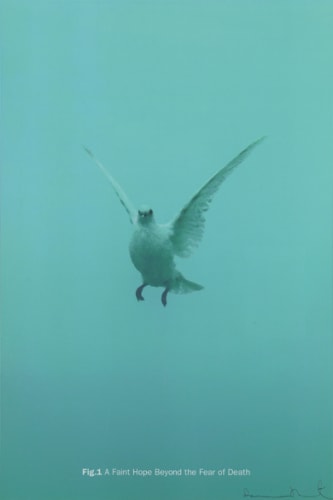Damien Hirst is one of a rare number of artists whose career can be seen as both a phenomenon of individual success and symbolic of an era. It is doubtful whether the journey that has distinguished Hirst’s career to date could ever be repeated by another artist. It is a journey which is directly connected not only with the art of his times but also with the methods by which his art is produced.
Hirst’s exhibition entitled “New Religion”, presented at the Benaki Museum in Athens, addresses themes which run throughout his artistic practice and gives us an insight into his way of working.
Born in Bristol in 1965 and raised in Leeds in the north of England, Damien Hirst studied first at Jacob Kramer College of Art in Leeds, from 1983-85, and Goldsmiths College, University of London, from 1986-89. In July of 1988, at the end of his second year at Goldsmiths, Hirst curated the now legendary independent student exhibition “Freeze”. The exhibition was later described by artist Michael Craig-Martin — creator of An Oak Tree (1974) and lecturer at Goldsmiths - as “a combination of youthful bravado, innocence, fortunate timing, good luck, and, of course, good work”. “Freeze” was to signal the creation and evolutionary course of the so- called ‘Young British Artists’ who came to prominence in the 1990s, the most celebrated of whom is undoubtedly Damien Hirst.
From A Thousand Years, 1990 (a vitrine containing a severed cow’s head, maggots and flies), and the monumental The Physical Impossibility of Death in the Mind of Someone Living, 1991 (a vitrine in which a shark is immersed in formaldehyde - an emblematic work for British art of the time), to For The Love of God (a human skull covered in diamonds), Hirst steadfastly tackles major themes in his work: death, the fragility of existence, and the meaning of life; the protagonists of a spectacle which prove to be consistently provocative and shocking.
Hirst has continued to curate exhibitions, including “Some Went Mad, Some Ran Away”, at the Serpentine Gallery in London in 1994 (for which he won the Turner Prize in 1995), in addition to exhibiting his work in both solo and group exhibitions in major museums and galleries throughout the world.
His artistic method provides a descriptive anatomy of his time, while also testing its boundaries. The clarity of his images and the immediacy of his message are characteristics of his work.
Free of remorse, Hirst uses and manipulates contemporary art’s processes of creation and promotion in a risky and bold manner. His decision to bypass the middlemen of art and the usual mechanisms of art promotion by taking an entire show of his work to auction at Sotheby’s in 2008, is typical. The financial result exceeded not only the ominous predictions of the critics but also his own personal expectations, breaking yet another record.
“New Religion” constitutes Damien Hirst’s first solo exhibition in Greece, offering the wider public the opportunity to come into contact with the work of an artist who continues to provoke passionate reactions. The exhibition addresses themes which run throughout his artistic practice and gives us an insight into his way of working.
A complete installation in itself, “New Religion” includes three series of silkscreen prints: “The Stations of the Cross”, following the journey of Christ to Golgotha; “The Wounds of Christ”, which comprises six separate images of the ‘stigmata’ presented within a single cruciform frame; and “The Apostles” , where different types of pharmaceuticals take the place of Christ and the twelve Apostles in a distinctly cool and clinical manner.
The centrepiece of “New Religion”, a large leather covered cabinet is reminiscent of Marcel Duchamp’s Boîte-en-valise, in that it potentially contains all the works of the exhibition whilst at the same time gives the impression that the entire exhibition unfolds from within it to fill the gallery space.
In The Holy Trinity, the Trinity is represented in a single silkscreen print as a statistical diagram, while The Last Supper illustrates a map of the World highlighting all those countries with nuclear capabilities. The Skull Beneath the Skin, a silkscreen print of a skull with its teeth covered in diamond dust, invites conflicting emotions; and the fragility of life is captured and conveyed to the viewer — perhaps more than by any other image in “New Religion” — by the delicate blue butterfly of The Soul on Jacob's Ladder.
Simultaneous displays of sculptures, constructions and paintings complete the installation which creates the sense of a chapel: a cross ornamented with pills, which like other precious stones assert their value for human life and prosperity; a silver heart pierced by razors and needles and wrapped in barbed wire; a child’s skull which, as with The Skull Beneath the Skin, hints at Hirst’s later work For the Love of God; and a giant pill in marble representing the holy communion, comprise an open list of questions posed by the artist in relation to science - and its role as a ‘new religion’ .
Using religious clichés — images, titles and associations — and transmuting them through art, within a cold and clinical environment typical of Hirst’s work, the artist bridges the theoretical gap between science and religion, re-phrasing questions about the way in which both are perceived.
Distancing himself from answers while also renouncing their final value and meaning, Hirst activates thought processes and questions that are posed beyond him, and stand on the most basic insecurities and fundamental fears of human existence.
As the artist said in his interview with Sean O’Hagan (London, May 2006): “...there [are] four important things in life: religion, love, art and science. At their best, they’re all just tools to help you find a path through the darkness. None of them really work that well, but they help. Of them all, science seems to be the one right now. Like religion, it provides the glimmer of hope that maybe it will be all right in the end”.

